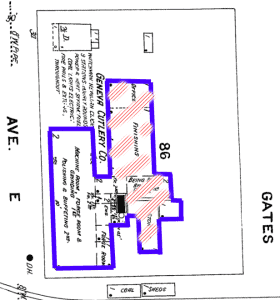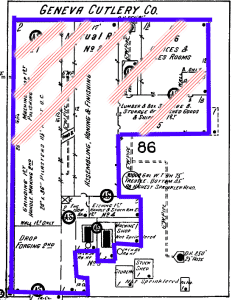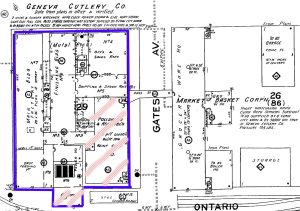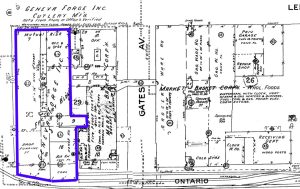Geneva Cutlery Company
By John Marks, Curator
Last month I wrote about the Geneva Shears Company that built the factory at 35 Lehigh Street. The company only lasted about 18 months. In January 1902 it was dissolved and reformed as the Geneva Cutlery Company.
Cutlery refers to knives for cutting food, but the company’s early product was straight razors. They made many different models of razors for every price range. Their success led to offices in London and Paris, and catalogues printed in French.
Back in Geneva, the factory was expanded to keep up with demand. For the 1909 Sanborn Fire Insurance Company footprint of the building, I’ve added the red stripes to indicate areas built since the previous map was issued. (You can see the first map of the building, drawn in 1903, in last month’s blog)
By 1915 the complex took up the whole block in two directions. Business was booming, but a change was coming in how men shaved.
In 1904 King Camp Gillette patented the disposable double edge razor blade. Known as a safety razor, it could be used with little skill unlike a straight razor. The blades never needed sharpening since they were thrown away when dull.
During World War I the US military issued safety razor kits to its troops. Gas masks were necessary for surviving trench warfare. Soldiers need clean-shaven faces for the masks to form a tight seal. Once men were used to safety razors, straight razor sales declined. Geneva Cutlery made disposable blades for a time but it wasn’t enough to keep the razor business going.
The company eventually switched to making kitchen knives. The forging and finishing processes were the same as for razors. The business was successful enough to expand a third time.
The 1925 Sanborn map showed two major developments. The plant expanded to the entire block between Avenue E and Gates Avenue. The Market Basket grocery chain built its wholesale operations next door. From Geneva they made and packaged products for their stores in Western New York and Pennsylvania. There was a third floor bridge across Gates Avenue, connecting the two companies.
In 1934, Ekco bought Geneva Cutlery and changed the name to Geneva Forge. The factory expanded to making all kinds of kitchen utensils and tools. In 1939 there was a rumor that Ekco wanted to leave Geneva. Money was raised to keep them here in a new factory, but US entry into World War II postponed their plans.
In 1947 Ekco moved into a new plant on Forge Avenue. That is where the story of the company and the building separate. The Sanborn map drawn that year showed that Market Basket had taken over the north half of the cutlery building for dry storage.
The 1947 outline represents the building as it is today. Next month I’ll conclude the story of the building and its occupants.





John, Great story and a great amount of detailed information. Thanks for doing the research and sharing it.
Thank you for this great information. I was born in Geneva, where my mother’s family lived while my Air Force father was on remote reconnaissance assignment in Turkey. After my father-in-law passed, I was given a cigar box of straight razors he had accumulated. To my pleasant surprise, two of them are from the Geneva Cutlery Company. Finding the article was great.
Interesting. Looking through my box of “stuff” today and decided to look up Geneva Cutlery stamped on the bread knife blade. Enjoyed the read and history.
Thank you for this history. Just bought a bakelite carving set with a stainless steel fork and knife marked Geneva Forge, so very glad to find your blog. Always research the items I get for my antique business as I really like to know what I have – customers like it too.
I grew up in Geneva and as a kid I used to fish along the shore near Geneva Cutlery. I remember finding thousands of castoff stampings left behind after the blades were removed. I have a butcher knife in my collection with the company icon of two smiths wielding hammers.
I have a Geneva Tempered Hi-Carbon USA knife, that belonged to my Grandpa it was in the kitchen for as long as I can remember. Would it be possible to get some information about the knife